Opinion & Analysis
Behind the numbers: A road map for an 18 handicap to get down to a 9
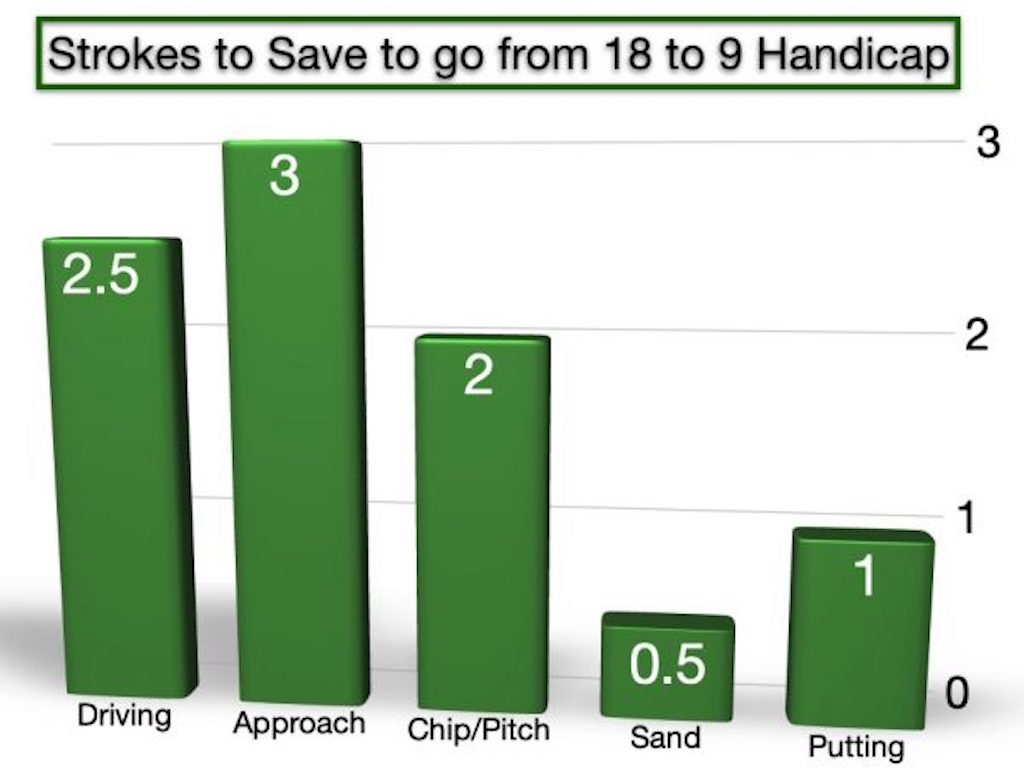
I wrote an article four years ago for GolfWRX called “The statistical differences between a scratch golfer and a PGA Tour player.” This article became one of the most-viewed features for the site, totaling over 420,000 views to date. I recently consulted with Ben Alberstadt, GolfWRX’s Editor-in-Chief, about pulling together some numbers for handicap levels to which more of us can relate.
You might ask: How do I know the differences between these handicap levels? Well, it is my full-time job to know about the numbers behind the game of golf—at all levels. I have been a student of the game from a statistical standpoint for 30-plus years. I created the strokes gained analysis website, ShotByShot.com, used by thousands of amateur golfers to improve by isolating the strengths and weaknesses of their games. Additionally, I work with PGA Tour players to extract clear answers from the Tour’s overwhelming 650-plus ShotLink stats.
I’ve learned that there is no such thing as an “average” game, no matter the handicap level. We’re all snowflakes and find our own unique way to shoot our number. With that said, ShotByShot.com’s 384,000-plus round database enables us to create a composite of the average golfer at each level. One of the beauties is that our data is robust and smooth across all five major facets so that any golfer’s strengths and weaknesses—and we all have them—stand out clearly by comparison.
The Data We Used
- 18 Handicap: I averaged the 3,551 rounds in our database that match the 18 Differential from Slope Adjusted Course Rating. In other words, the Best eight of 20 rounds when Mr. 18 actually played to an 18 handicap.
- 9 Handicap: Similarly, his Best eight out of 20 using the 5,000 applicable rounds in our database.
As you might guess, the difference between these two in scores is nine strokes. So, if your snowflake matches or is close to Mr. 18’s, simply drop the shots below by facet and voila you are there.
The chart below shows the distribution of the strokes by facet that Mr. 18 needs to save to join Mr. 9.
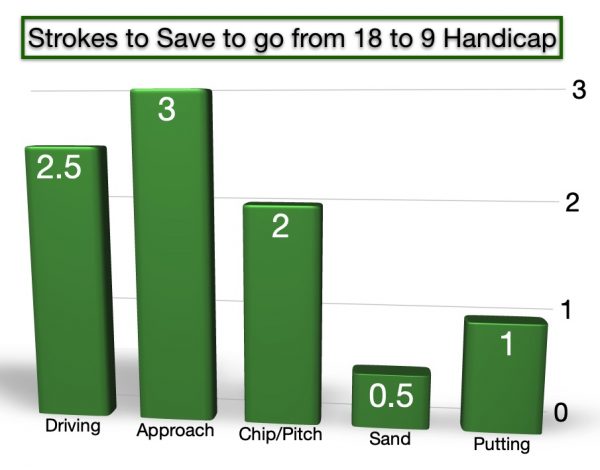
Driving
Skill in this critical facet of the game is measured by distance and accuracy. But let’s take distance out of the equation by assuming we’re all playing the correct tees for our games and focus on accuracy.
As the chart above indicates, we are looking for 2.5 strokes on, what for a typical golf course, is 14 driving holes. The chart below shows results in the average round for Mr. 18 and Mr. 9. Note that both make at least one Driving Error* per round. Weed out that error and you can be more than halfway home, especially if it is a Penalty Error** that tends to carry a cost of between 1.3 strokes (penalty with drop) and two-plus strokes (stroke and distance).
*No Shot Driving Errors = Balls hit out of play that cannot return to normal play with an advancement shot.
**Penalty Error = a. Stroke with drop, or b. Stroke and distance.
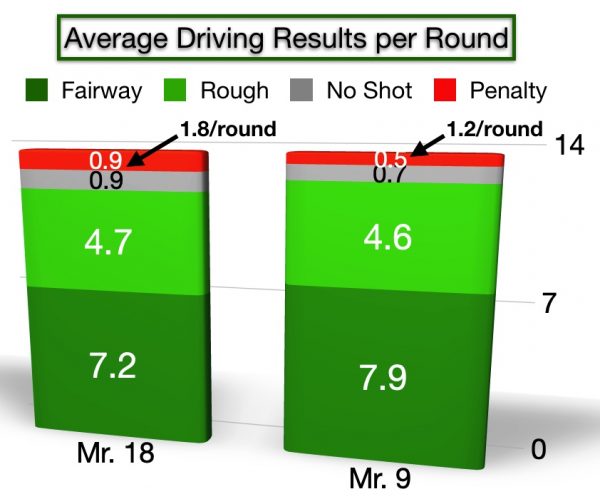
This may be easier said than done, but sometimes the fix is as simple as target and club selection from the tee. Sure, it works to aim away from trouble but try choosing a club that cannot reach the trouble. Most holes that feature trouble off the tee will also be stroke holes, even for Mr. 9. Avoid the error and take double-bogey out of play. This is also a valuable strategy for match play situations.
Next, strive to hit at least one more fairway. The approach accuracy charts below show how many more greens are hit from the fairway vs. rough.
Approach Shots
Here we need to save 3 strokes. This facet involves the greatest number of long game opportunities–on average 17.6 full swing attempts per round. These attempts are generally split 70 percent from the fairway and 30 percent from the rough. Let’s ignore the sand for now as it accounts for approximately only 1 shot every three-plus rounds. Except to say that when you find yourself in a fairway bunker, it is usually a mistake, so take your medicine, get back in play and avoid doubling the pain.
So where to save three strokes? Avoid penalties and that’s at least one stroke. Then hit three more greens in regulation and you’re there–Mr. 18 averages five GIRs vs. Mr. 9’s eight. The key is to improve accuracy.
I recommend working on the distance ranges circled in the charts below and devoting 70 percent of your work to fairway shots. From distances longer than the circled ranges, make smart choices, play within your capabilities and avoid errors and penalties. Easy?! At either handicap level, from long-range you’ll miss more greens than you hit. Knowing this, work toward “good misses” – the fat side of the green, short but in the fairway, etc. Finally, my data supports that hitting the green is far more important than worrying about “proximity to the hole”. But that’s another article.
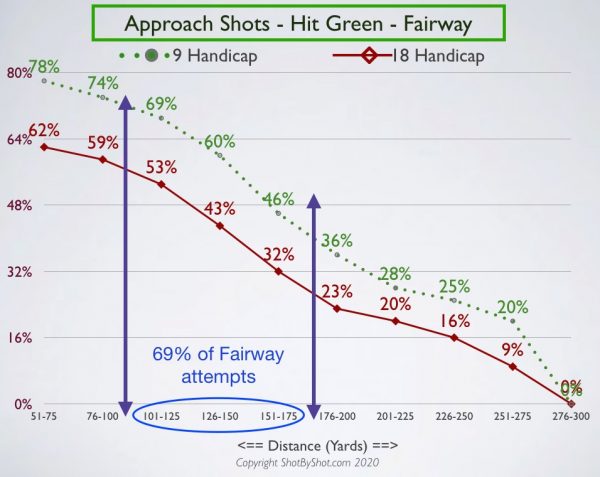
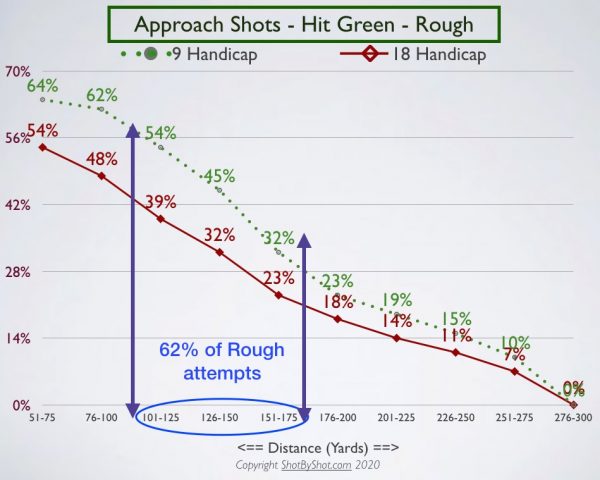
Chip/Pitch Shots (within 50 yards of the hole)
Here we are looking to save 2 strokes in a less frequently used part of the game–ten shots per round for Mr. 18 vs. eight shots for Mr. 9. Again, please start with avoiding Errors*. My pro and mentor spent hours on the short game with me. First, valuable technique instruction and then competitions @ $1.00 per shot—best lessons ever! His method was to break the shot opportunities into three categories, and this goes for the Sand game as well. Try it—it works.
- Green light: Good lie, no trouble–try to hole it
- Yellow light: Difficult but doable–play conservatively and try to be left with an uphill, makeable putt.
- Red light: Very difficult with looming downside–just get the ball on the green and avoid the error.
Next, practice the type of shots that you face the most and especially those that tend to give you problems. Bottom line, hit more shots closer to the hole and avoid costly errors. While this sounds like annoyingly obvious advice, maybe it will help to consider that Mr. 18 saves 20 percent of these opportunities vs. 32 percent for Mr. 9.
*Short Game Errors: The shot misses the green AND requires 4 or more strokes to hole out.
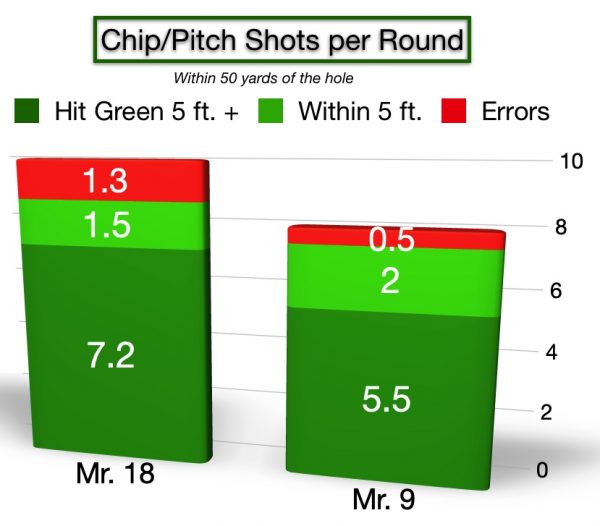
Sand Shots (within 50 yards of the hole)
Here we are looking to save half a shot in a very small part of the game—just 2 and 1.6 shots per round respectively for Mr. 18 and Mr. 9. I view this an underrated skill that definitely produces more errors per attempt than any other part of the game. When I was learning the game, I was afraid of the gaping bunkers that surrounded and protected ALL of our 18 greens. It wasn’t until I worked hard to gain real confidence from the sand that the greens seemed larger and easier to hit. Again, avoid errors and you’ll solve this portion of the puzzle. Mr. 18 saves 12 percent of his sand opportunities (with 28 percent errors) vs. 21 percent saves for Mr. 9 (15 percent errors).
*Short Game Errors: The shot misses the green AND requires 4 or more strokes to hole out.
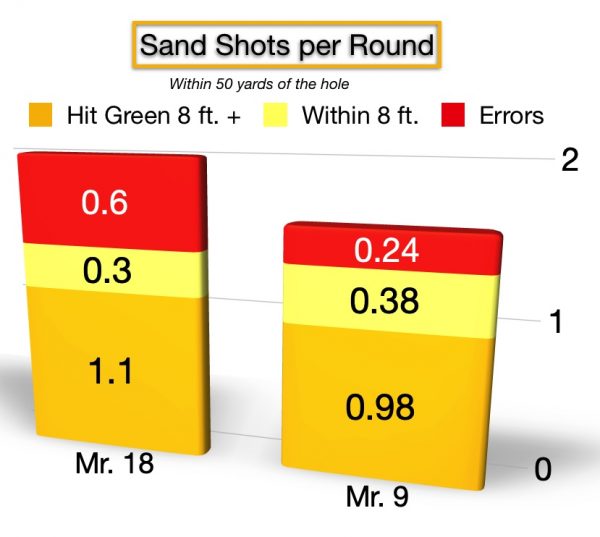
Putting
Putting is 40 percent of the game at all levels and we need to save 1 stroke. EASY, Mr. 18 simply needs to reduce his 3-putts from 2.5 per round to 1.5. Do this by working on distance control from 20 to 50 feet. Beyond 50 feet think of it as more of an easy chip shot with your putter. You’re doing well if you leave it within 10 percent of the original distance and below the hole. Finally, work on your short putts in the three-to-10-foot ranges. I recommend starting with three feet, then move to four to five feet. If you can get those ranges to Mr. 9’s one-putt numbers, you’re well on your way.
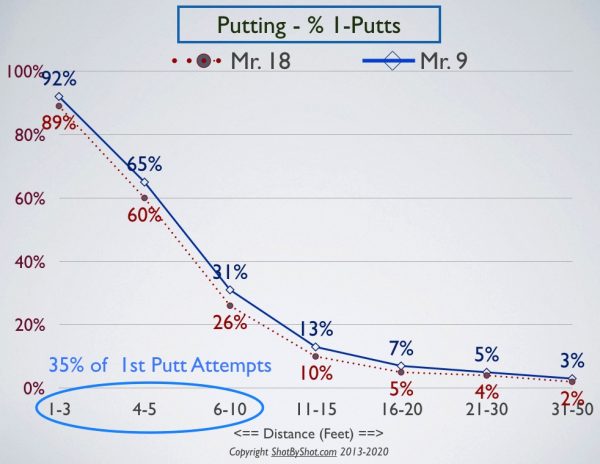
Conclusion
Bottom line, I have laid out where, on average, Mr. 18 needs to improve to make the leap to Mr. 9. If you made it this far, you may be saying, “Why all the focus on errors?” Simple! They are important! Most stat programs ignore them—the PGA Tour certainly does. My studies show that the relative frequency and severity of errors do more determine one’s scoring level than do all the good and average shots played.
Your game will no doubt have different areas of strength and weakness. The key is to accurately identify them so that you can address them appropriately. This article has hopefully given you some ideas about how to do that.
For a complete strokes gained analysis of your game, go to: www.ShotByShot.com
- LIKE441
- LEGIT48
- WOW14
- LOL8
- IDHT3
- FLOP2
- OB3
- SHANK11
Instruction
The Wedge Guy: The easiest-to-learn golf basic

My golf learning began with this simple fact – if you don’t have a fundamentally sound hold on the golf club, it is practically impossible for your body to execute a fundamentally sound golf swing. I’m still a big believer that the golf swing is much easier to execute if you begin with the proper hold on the club.
As you might imagine, I come into contact with hundreds of golfers of all skill levels. And it is very rare to see a good player with a bad hold on the golf club. There are some exceptions, for sure, but they are very few and very far between, and they typically have beat so many balls with their poor grip that they’ve found a way to work around it.
The reality of biophysics is that the body moves only in certain ways – and the particulars of the way you hold the golf club can totally prevent a sound swing motion that allows the club to release properly through the impact zone. The wonderful thing is that anyone can learn how to put a fundamentally sound hold on the golf club, and you can practice it anywhere your hands are not otherwise engaged, like watching TV or just sitting and relaxing.
Whether you prefer an overlap, interlock or full-finger (not baseball!) grip on the club, the same fundamentals apply. Here are the major grip faults I see most often, in the order of the frequency:
Mis-aligned hands
By this I mean that the palms of the two hands are not parallel to each other. Too many golfers have a weak left hand and strong right, or vice versa. The easiest way to learn how to hold the club with your palms aligned properly is to grip a plain wooden ruler or yardstick. It forces the hands to align properly and shows you how that feels. If you grip and re-grip a yardstick several times, then grip a club, you’ll see that the learning curve is almost immediate.
The position of the grip in the upper/left hand
I also observe many golfers who have the butt of the grip too far into the heel pad of the upper hand (the left hand for right-handed players). It’s amazing how much easier it is to release the club through the ball if even 1/4-1/2″ of the butt is beyond the left heel pad. Try this yourself to see what I mean. Swing the club freely with just your left hand and notice the difference in its release from when you hold it at the end of the grip, versus gripping down even a half inch.
To help you really understand how this works, go to the range and hit shots with your five-iron gripped down a full inch to make the club the same length as your seven-iron. You will probably see an amazing shot shape difference, and likely not see as much distance loss as you would expect.
Too much lower (right) hand on the club
It seems like almost all golfers of 8-10 handicap or higher have the club too far into the palm of the lower hand, because that feels “good” if you are trying to control the path of the clubhead to the ball. But the golf swing is not an effort to hit at the ball – it is a swing of the club. The proper hold on the club has the grip underneath the pad at the base of the fingers. This will likely feel “weak” to you — like you cannot control the club like that. EXACTLY. You should not be trying to control the club with your lower/master hand.
Gripping too tightly
Nearly all golfers hold the club too tightly, which tenses up the forearms and prevents a proper release of the club through impact. In order for the club to move back and through properly, you must feel that the club is controlled by the last three fingers of the upper hand, and the middle two fingers of the lower hand. If you engage your thumbs and forefingers in “holding” the club, the result will almost always be a grip that is too tight. Try this for yourself. Hold the club in your upper hand only, and squeeze firmly with just the last three fingers, with the forefinger and thumb off the club entirely. You have good control, but your forearms are not tense. Then begin to squeeze down with your thumb and forefinger and observe the tensing of the entire forearm. This is the way we are made, so the key to preventing tenseness in the arms is to hold the club very lightly with the “pinchers” — the thumbs and forefingers.
So, those are what I believe are the four fundamentals of a good grip. Anyone can learn them in their home or office very quickly. There is no easier way to improve your ball striking consistency and add distance than giving more attention to the way you hold the golf club.
More from the Wedge Guy
- The Wedge Guy: Golf mastery begins with your wedge game
- The Wedge Guy: Why golf is 20 times harder than brain surgery
- The Wedge Guy: Musings on the golf ball rollback
- LIKE83
- LEGIT13
- WOW4
- LOL1
- IDHT0
- FLOP4
- OB1
- SHANK8
19th Hole
Vincenzi’s 2024 Texas Children’s Houston Open betting preview

As the Florida swing comes to an end, the PGA Tour makes its way to Houston to play the Texas Children’s Houston Open at Memorial Park Golf Course.
This will be the fourth year that Memorial Park Golf Course will serve as the tournament host. The event did not take place in 2023, but the course hosted the event in 2020, 2021 and 2022.
Memorial Park is a par-70 layout measuring 7,432 yards and features Bermudagrass greens. Historically, the main defense for the course has been thick rough along the fairways and tightly mown runoff areas around the greens. Memorial Park has a unique setup that features three Par 5’s and five Par 3’s.
The field will consist of 132 players, with the top 65 and ties making the cut. There are some big names making the trip to Houston, including Scottie Scheffler, Wyndham Clark, Tony Finau, Will Zalatoris and Sahith Theegala.
Past Winners at Memorial Park
- 2022: Tony Finau (-16)
- 2021: Jason Kokrak (-10)
- 2020: Carlos Ortiz (-13)
In this article and going forward, I’ll be using the Rabbit Hole by Betsperts Golf data engine to develop my custom model. If you want to build your own model or check out all of the detailed stats, you can sign up using promo code: MATTVIN for 25% off any subscription package (yearly is best value).
Key Stats For Memorial Park
Let’s take a look at several metrics for Memorial Park to determine which golfers boast top marks in each category over their last 24 rounds:
Strokes Gained: Approach
Memorial Park is a pretty tough golf course. Golfers are penalized for missing greens and face some difficult up and downs to save par. Approach will be key.
Total Strokes Gained: Approach per round in past 24 rounds:
- Tom Hoge (+1.30)
- Scottie Scheffler (+1.26)
- Keith Mitchell (+0.97)
- Tony Finau (+0.92)
- Jake Knapp (+0.84)
Strokes Gained: Off the Tee
Memorial Park is a long golf course with rough that can be penal. Therefore, a combination of distance and accuracy is the best metric.
Total Strokes Gained: Off the Tee per round in past 24 rounds:
- Scottie Scheffler (+0.94)
- Kevin Dougherty (+0.93)
- Cameron Champ (+0.86)
- Rafael Campos (+0.84)
- Si Woo Kim (+0.70)
Strokes Gained Putting: Bermudagrass + Fast
The Bermudagrass greens played fairly fast the past few years in Houston. Jason Kokrak gained 8.7 strokes putting on his way to victory in 2021 and Tony Finau gained in 7.8 in 2022.
Total Strokes Gained Putting (Bermudagrass) per round past 24 rounds (min. 8 rounds):
- Adam Svensson (+1.27)
- Harry Hall (+1.01)
- Martin Trainer (+0.94)
- Taylor Montgomery (+0.88)
- S.H. Kim (+0.86)
Strokes Gained: Around the Green
With firm and undulating putting surfaces, holding the green on approach shots may prove to be a challenge. Memorial Park has many tightly mowed runoff areas, so golfers will have challenging up-and-down’s around the greens. Carlos Ortiz gained 5.7 strokes around the green on the way to victory in 2020.
Total Strokes Gained: Around the Green per round in past 24 rounds:
- Mackenzie Hughes (+0.76)
- S.H. Kim (+0.68)
- Scottie Scheffler (+0.64)
- Jorge Campillo (+0.62)
- Jason Day (+0.60)
Strokes Gained: Long and Difficult
Memorial Park is a long and difficult golf course. This statistic will incorporate players who’ve had success on these types of tracks in the past.
Total Strokes Gained: Long and Difficult in past 24 rounds:
- Scottie Scheffler (+2.45)
- Ben Griffin (+1.75)
- Will Zalatoris (+1.73)
- Ben Taylor (+1.53)
- Tony Finau (+1.42)
Course History
Here are the players who have performed the most consistently at Memorial Park.
Strokes Gained Total at Memorial Park past 12 rounds:
- Tyson Alexander (+3.65)
- Ben Taylor (+3.40)
- Tony Finau (+2.37)
- Joel Dahmen (+2.25)
- Patton Kizzire (+2.16)
Statistical Model
Below, I’ve reported overall model rankings using a combination of the five key statistical categories previously discussed.
These rankings are comprised of SG: App (24%) SG: OTT (24%); SG: Putting Bermudagrass/Fast (13%); SG: Long and Difficult (13%); SG: ARG (13%) and Course History (13%)
- Scottie Scheffler
- Wyndham Clark
- Tony Finau
- Joel Dahmen
- Stephan Jaeger
- Aaron Rai
- Sahith Theegala
- Keith Mitchell
- Jhonnatan Vegas
- Jason Day
- Kurt Kitayama
- Alex Noren
- Will Zalatoris
- Si Woo Kim
- Adam Long
2024 Texas Children’s Houston Open Picks
Will Zalatoris +2000 (Caesars)
Scottie Scheffler will undoubtedly be difficult to beat this week, so I’m starting my card with someone who I believe has the talent to beat him if he doesn’t have his best stuff.
Will Zalatoris missed the cut at the PLAYERS, but still managed to gain strokes on approach while doing so. In an unpredictable event with extreme variance, I don’t believe it would be wise to discount Zalatoris based on that performance. Prior to The PLAYERS, the 27-year-old finished T13, T2 and T4 in his previous three starts.
Zalatoris plays his best golf on long and difficult golf courses. In his past 24 rounds, he ranks 3rd in the category, but the eye test also tells a similar story. He’s contended at major championships and elevated events in the best of fields with tough scoring conditions. The Texas resident should be a perfect fit at Memorial Park Golf Club.
Alex Noren +4500 (FanDuel)
Alex Noren has been quietly playing some of his best golf of the last half decade this season. The 41-year-old is coming off back-to-back top-20 finishes in Florida including a T9 at The PLAYERS in his most recent start.
In his past 24 rounds, Noren ranks 21st in the field in Strokes Gained: Off the Tee, 30th in Strokes Gained: Around the Green, 25th in Strokes Gained: Total on long and difficult courses and 21st in Strokes Gained: Putting on fast Bermudagrass greens.
In addition to his strong recent play, the Swede also has played well at Memorial Park. In 2022, Noren finished T4 at the event, gaining 2.2 strokes off the tee and 7.0 strokes on approach for the week. In his two starts at the course, he’s gained an average of .6 strokes per round on the field, indicating he is comfortable on these greens.
Noren has been due for a win for what feels like an eternity, but Memorial Park may be the course that suits him well enough for him to finally get his elusive first PGA Tour victory.
Mackenzie Hughes +8000 (FanDuel)
Mackenzie Hughes found himself deep into contention at last week’s Valspar Championship before faltering late and finishing in a tie for 3rd place. While he would have loved to win the event, it’s hard to see the performance as anything other than an overwhelming positive sign for the Canadian.
Hughes has played great golf at Memorial Park in the past. He finished T7 in 2020, T29 in 2021 and T16 in 2022. The course fit seems to be quite strong for Hughes. He’s added distance off the tee in the past year or and ranks 8th in the field for apex height, which will be a key factor when hitting into Memorial Park’s elevated greens with steep run-off areas.
In his past 24 rounds, Hughes is the best player in the field in Strokes Gained: Around the Greens. The ability to scramble at this course will be extremely important. I believe Hughes can build off of his strong finish last week and contend once again to cement himself as a President’s Cup consideration.
Akshay Bhatia +8000 (FanDuel)
Akshay Bhatia played well last week at the Valspar and seemed to be in total control of his golf ball. He finished in a tie for 17th and shot an impressive -3 on a difficult Sunday. After struggling Thursday, Akshay shot 68-70-68 in his next three rounds.
Thus far, Bhatia has played better at easier courses, but his success at Copperhead may be due to his game maturing. The 22-year-old has enormous potential and the raw talent to be one of the best players in the world when he figures it all out.
Bhatia is a high upside play with superstar qualities and may just take the leap forward to the next stage of his career in the coming months.
Cameron Champ +12000 (FanDuel)
Cameron Champ is a player I often target in the outright betting market due to his “boom-or-bust” nature. It’s hard to think of a player in recent history with three PGA Tour wins who’s been as inconsistent as Champ has over the course of his career.
Despite the erratic play, Cam Champ simply knows how to win. He’s won in 2018, 2019 and 2021, so I feel he’s due for a win at some point this season. The former Texas A&M product should be comfortable in Texas and last week he showed us that his game is in a pretty decent spot.
Over his past 24 rounds, Champ ranks 3rd in Strokes Gained: Off the Tee and 30th in Strokes Gained: Total on long and difficult courses. Given his ability to spike at any given time, Memorial Park is a good golf course to target Champ on at triple digit odds.
Robert MacIntyre +12000 (FanDuel)
The challenge this week is finding players who can possibly beat Scottie Scheffler while also not dumping an enormous amount of money into an event that has a player at the top that looks extremely dangerous. Enter McIntyre, who’s another boom-or-bust type player who has the ceiling to compete with anyone when his game is clicking on all cylinders.
In his past 24 rounds, MacIntyre ranks 16th in the field in Strokes Gained: Off the Tee, 17th in Strokes Gained: Around the Green and 10th in Strokes Gained: Total on long and difficult courses.
MacIntyre’s PGA Tour season has gotten off to a slow start, but he finished T6 in Mexico, which is a course where players will hit driver on the majority of their tee shots, which is what we will see at Memorial Park. Texas can also get quite windy, which should suit MacIntyre. Last July, the Scot went toe to toe with Rory McIlroy at the Scottish Open before a narrow defeat. It would take a similar heroic effort to compete with Scheffler this year in Houston.
Ryan Moore +15000 (FanDuel)
Ryan Moore’s iron play has been absolutely unconscious over his past few starts. At The PLAYERS Championship in a loaded field, he gained 6.1 strokes on approach and last week at Copperhead, he gained 9.0 strokes on approach.
It’s been a rough handful of years on Tour for the 41-year-old, but he is still a five-time winner on the PGA Tour who’s young enough for a career resurgence. Moore has chronic deterioration in a costovertebral joint that connects the rib to the spine, but has been getting more consistent of late, which is hopefully a sign that he is getting healthy.
Veterans have been contending in 2024 and I believe taking a flier on a proven Tour play who’s shown signs of life is a wise move at Memorial Park.
- LIKE15
- LEGIT1
- WOW1
- LOL0
- IDHT0
- FLOP0
- OB0
- SHANK2
Opinion & Analysis
Ryan: Why the race to get better at golf might be doing more harm than good

B.F. Skinner was one of the most important psychologists of the 20th century, developing the foundation of the development of reinforcement, and in doing so, creating the concept of behaviorism. In simple terms, this means that we are conditioned by our habits. In practical terms, it explains the divide between the few and far between elite instructors and college coaches.
To understand the application, let’s quickly review one of B.F. Skinner’s most important experiments; superstitions in the formation of behavior by pigeons. In this experiment, food was dispensed to pigeons at random intervals. Soon, according to Skinner, the pigeons began to associate whatever action they were doing at the time of the food being dispensed. According to Skinner, this conditioned that response and soon, they simply haphazardly repeated the action, failing to distinguish between cause and correlation (and in the meantime, looking really funny!).
Now, this is simply the best way to describe the actions of most every women’s college golf coach and too many instructors in America. They see something work, get positive feedback and then become conditioned to give the feedback, more and more, regardless of if it works (this is also why tips from your buddies never work!).
Go to a college event, particularly a women’s one, and you will see coaches running all over the place. Like the pigeons in the experiment, they have been conditioned into a codependent relationship with their players in which they believe their words and actions, can transform a round of golf. It is simply hilarious while being equally perturbing
In junior golf, it’s everywhere. Junior golf academies make a living selling parents that a hysterical coach and over-coaching are essential ingredients in your child’s success.
Let’s be clear, no one of any intellect has any real interest in golf — because it’s not that interesting. The people left, including most coaches and instructors, carve out a small fiefdom, usually on the corner of the range, where they use the illusion of competency to pray on people. In simple terms, they baffle people with the bullshit of pseudo-science that they can make you better, after just one more lesson.
The reality is that life is an impromptu game. The world of golf, business, and school have a message that the goal is being right. This, of course, is bad advice, being right in your own mind is easy, trying to push your ideas on others is hard. As a result, it is not surprising that the divorce rate among golf professionals and their instructors is 100 percent. The transfer rate among college players continues to soar, and too many courses have a guy peddling nefarious science to good people. In fact, we do at my course!
The question is, what impact does all this have on college-age and younger kids? At this point, we honestly don’t know. However, I am going to go out on a limb and say it isn’t good.
Soren Kierkegaard once quipped “I saw it for what it is, and I laughed.” The actions of most coaches and instructors in America are laughable. The problem is that I am not laughing because they are doing damage to kids, as well as driving good people away from this game.
The fact is that golfers don’t need more tips, secrets, or lessons. They need to be presented with a better understanding of the key elements of golf. With this understanding, they can then start to frame which information makes sense and what doesn’t. This will emancipate them and allow them to take charge of their own development.
- LIKE14
- LEGIT4
- WOW1
- LOL2
- IDHT0
- FLOP1
- OB0
- SHANK11
-

 19th Hole1 week ago
19th Hole1 week agoJohn Daly stuns fans into silence with brutal opening tee shot on PGA Tour Champions
-

 19th Hole3 days ago
19th Hole3 days agoThings got heated at the Houston Open between Tony Finau and Alejandro Tosti. Here’s why
-

 19th Hole2 weeks ago
19th Hole2 weeks ago2-time major champ announces shock retirement from the sport at age of 33
-

 19th Hole1 week ago
19th Hole1 week agoCharlie Woods finds it tough going on American Junior Golf Association debut
-

 19th Hole2 weeks ago
19th Hole2 weeks agoEdoardo Molinari reveals the latest PGA Tour golfer to turn down ‘good offer’ from LIV Golf
-

 19th Hole2 weeks ago
19th Hole2 weeks agoScottie Scheffler had an interesting response when asked how he ‘quiets the noise’ following Players victory
-

 19th Hole2 weeks ago
19th Hole2 weeks agoJon Rahm dealt fresh blow to hopes of qualifying for 2025 Ryder Cup
-

 19th Hole11 hours ago
19th Hole11 hours agoReport: Tiger Woods has ‘eliminated sex’ in preparation for the 2024 Masters







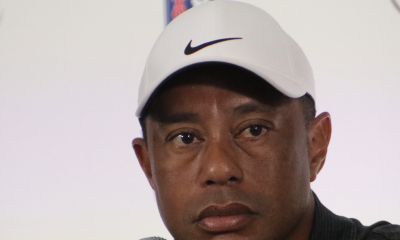

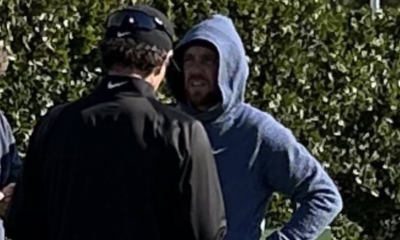
















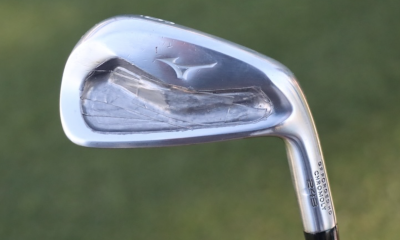

Jnak97
Apr 14, 2020 at 3:29 pm
I second the idea of doing another follow up article. Though, since your last article shows Mr. Scratch as a 73ish scoring average, maybe we could compare the single digit to someone that is averaging 1 or 2 under par. So I guess a +1 or +2 handicap would make a more informative comparison. We already have the stats for a 9 and 0 handicap based on this article and your previous, but it would be nice to have a reference for how to break par!
John Stafford
Mar 30, 2020 at 8:53 pm
Great analysis. I’ve learned (as a 20 handicapper) that I don’t need to hit the ball any longer (or even that much straighter) to be a 10 handicapper. All I need to do is take my best 9 holes and do it for 15 holes. No penalties. Quit using driver and switch to 3 wood at first sign of trouble (most holes only give you 0.2 strokes or so advantage with driver, one penalty outweighs the entire round). No muffed irons, no muffed chips, don’t hit into sand traps except with long irons. Aim for 2 putts instead of the cup. Wedge forward 70 yards from trouble vs. a low probability 150+ yard shot. If only my body wasn’t breaking down as I’m getting so much smarter.
Peter Sanders
Apr 3, 2020 at 10:38 am
Well done John, you solved the puzzle on your own just as I did years ago.
Chris G.
Mar 29, 2020 at 1:45 am
Is it possible to get the statistics to go from Mr. 9 to Mr. Scratch?
pls don’t make me wait 4 yrs, I could be an 18 by then
Peter Sanders
Mar 29, 2020 at 11:16 am
Chris,
Certainly possible. I discussed with the Editor following up with 5 handicap to Scratch. IF, this article were well received.
At the risk of sounding self-serving… If you subscribe to ShotByShot.com, you can select the lower handicap “Target” and the system will guide you to where you want to go. I suggest starting with the 6-9 Target range. When you get there, 4-5 and on down to 0-2 and even lower.
Thanks for your question and please let me know how you do.
Chris G.
Mar 29, 2020 at 12:05 pm
Thank you for the response Peter.
when my expendable income returns, I will give it a shot
Peter Sanders
Mar 30, 2020 at 10:09 am
I understand! Let’s hope it is still golf season!
Peter Sanders
Mar 30, 2020 at 10:10 am
Chris,
Are you somewhere where you can play now?
Chris G.
Mar 30, 2020 at 12:45 pm
The short answer is no. There is a golf course 1 hour away from me that is open, but I am only driving to work and the store. I rode my bike to my local muni but they are closed for now.
Bob Jones
Mar 27, 2020 at 10:15 am
I did just this. I did it by learning how to hit the ball straight, getting VERY good at approach putting and chipping, and learning how to play the game. There were other things, too, like learning how to hit from uneven lies, fairway bunkers, rough, greenside bunkers, chipping from strange places around the green, so I was seldom at a loss for how to stay on offense from challenging spots, but it was mainly those first three things.
Peter Sanders
Mar 28, 2020 at 10:52 am
Thanks Bob! Sounds like you worked hard and figured it out on your own. Well done!
Peter Sanders
Mar 27, 2020 at 9:50 am
I’m with you 100% Jack! My long time friends and I, that used to relish the challenge from the back tees, now unabashedly pass them and walk proudly to the Sr./forward tees. The game is still as fun and competitive!
Jack Nash
Mar 27, 2020 at 9:27 am
Great article
I haven’t used this tech language per say but over the years I’ve managed to play smarter. Getting older, having injuries and losing distance has taught me to use the right club(more club) more often and miss it on the proper side. Oh, and playing it forward makes the game fun again. If it’s feeling like work, you’re on the wrong tee box.